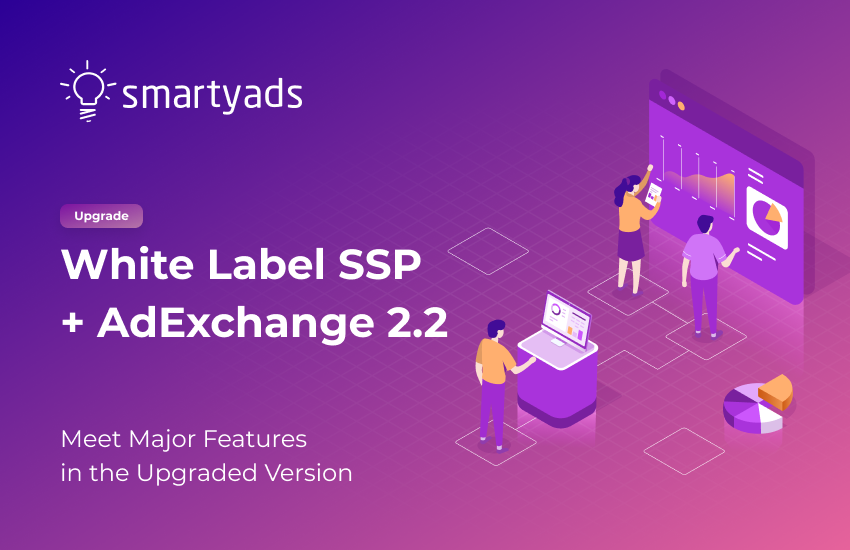A long time has passed since we last introduced epic updates on WLS SSP+Ad Exchange 2.2. This is because we’ve been relentlessly working on the new round of useful features and now we are happy to cheer you us with some successful results of our work. The biggest advantages of this massive update will be represented by custom integrations on-demand, SkadNetwork support, dynamic margin, advanced QPS distribution, and other useful features. So, let’s review the whole update step-by-step.
Flexible vs. Fixed Price model for Publishers
The cost regulation per bid gets much easier to handle. For your convenience, we’ve arranged everything in a single dropdown menu called Bid Price. In this menu, you can select 2 options: Bid Floor and Fixed Bid Price. Use one of the fields from the drop-down menu to set the bid price you want to receive for 1000 impressions. With a fixed bid price, the bid response will exactly match the fixed bid price. When it is set - all requests with a higher bid floor sent by the publisher will be dropped and not sent to the DSP.
SkadNetwork support
As you might already know, SKAdNetwork from Apple makes it possible to attribute app installations to a specific advertising campaign without using an IDFA, that is, while maintaining user privacy. With SKAdNetwork support, the bid requests include new objects that provide the necessary information required for privacy-friendly ad serving. Your system is now equipped with SKAdNetwork support - "2.0" or higher - dependent on both the OS version and the app SDK version.
Custom integrations on demand
Bidswitch, Appnexus, Pubmatic, Verizon, Epsilon, OpenX, and other renowned demand providers have special requirements for the requests and responses structure as well as API analytics exchange when integrated. We have developed this data flow instruments to allow connection out from the platform basic box. Thus, when you will be connecting a DSP endpoint for such a demand, you will need to select a specifically suited adapter type in general settings (from a dropdown menu) and then complete the endpoint setting procedure. In the WLS SSP+Ad Exchange 2.2, we’ve also updated the list of DSP adapters with the following ones: Improve digital, Synacor, and Rich audience.
Dynamic margin feature to maximize net profit
Now you can find a dynamic margin toggle on SSP endpoint settings. With this toggle, you can define the dynamic margin by specifying the percentage of the possible profit that the supplier should receive. This way, you allocate the forecasted price share for your supplier and increase your profit from every bid.
Advanced QPS distribution algorithm
We’ve adjusted the QPS limit on DSP according to the number of machines in the infrastructure so that the system could better handle changing amounts of traffic (based on your traffic scale volumes). This way, the system becomes flexible enough to adapt to the changing needs of media trading as the traffic grows. As a result, this mechanism provides advanced media-trading outcomes.
Users creation by admins
From now on, the admin can create users of all user roles in the system. After the admin clicks on the button ‘create user’, the new page will appear suggesting to fill in the fields like name, company, country, email, etc. At the end of the form, the admin will select the user role from the dropdown list: Admin (by default), SSP, DSP, Publisher. This allows you to choose whether you want to build a self-served product for your clients or you manage their accounts on your own.
Rewarded videos:
Toggle in video placement settings. Previously, when SSP sent rewarded traffic to DSP, DSP did not recognize that traffic as rewarded because such information wasn’t indicated in requests. For this reason, we’ve added a toggle into video placement settings (in DSP endpoints, advanced settings). The toggle is set to OFF by default, but when it is ON, the system will send the indication that it is rewarded video traffic in all requests.
Recording rewarded video request to the report. Previously rewarded video request on DSP and SSP platforms was defined in a different way and it wasn’t convenient to analyze how many rewarded video requests have been sent to the platform from Unity. Now a rewarded video request on the SSP is recorded to the Ad Exchange report for Unity Company based on their specific parameter.
Rewarded video filter on DSP. Rewarded video filter was added in the creative settings on DSP (this filter option will only appear when the creative is video). When this toggle is off both rewarded video and all other formats will be suitable. When the toggle is ON, then DSP will only bid on Rewarded videos and no other formats.
GDPR:
GDPR consent toggle moved from inventory settings to DSP advanced settings. Now, in the DSP advanced settings, you can find a GDPR consent toggle. This toggle is a very convenient leverage that helps you to verify that your EU traffic complies with the principles of European privacy regulations. The GDPR toggle is turned off by default, however, when the toggle is on, the system will only pass requests that contain GDPR consent in them.
We also removed the GDPR consent toggle from inventory settings since the platform should pass GDPR:1 or GDPR:0 depending on the country the request was sent from (not on the toggle). Thus, this option is no longer needed, and that’s why we removed it from the UI.
GDPR support by default. In Administration, platform settings, we added the new section GDPR & TCF 2.0. There you can find GDPR toggle and the field Vendor ID. GDPR toggle is ON by default but can be switched OFF by Admin. The field Vendor ID is optional and supports only numeric value. It’s displayed only when GDPR toggle is ON; when GDPR toggle is OFF → Vendor ID field is hidden.
Incoming traffic overview:
Reasons of requests failure. Only valid requests that passed all SSP filters and validation on the platform will be recorded to SSP requests in the Ad Exchange report and Requests in the Publishers' Report. All other requests will be displayed in the incoming traffic overview with the corresponding failure reason:
- Request is blocked by Filter List Manager blacklist
- Request is blocked by Filter List Manager whitelist
- Request is blocked by supply scanner
This way, you can stay informed even better regarding how your system operates and make necessary manipulations later.
Analyzing previous periods. Menus of "Incoming traffic overview", "Outgoing traffic overview" and "Bid responses overview" normally display only currently active SSPs and DSPs. However, you can select previous dates to check the data for SSP/DSPs which are not active now but were active during a certain period in the past - yesterday/day before yesterday, and so on. When the SSP/DSP is inactive - it will be displayed it in the following format - (Not Active) DSP/SSP name DSP/SSP id.
Granular filers. Now in the bids overview report, you can analyze direct supply on the level of a particular publisher, inventory, or placement. If any publisher is selected, then inventories and placements for the selected publisher will be displayed. If you select some placement, you still can select other inventories or publishers. Still, note that if you select some placement and then select inventory that is not related to this placement, the placement selection should be removed.
QPS limit overview. When the QPS limit is too low and traffic is not sent to the DSP because of that, the system will record the following reason in the Outgoing traffic overview: QPS limit is too low. This will reflect the true state of things, enabling the platform owners to take the necessary actions to optimize their advertising ecosystem.
Support of all API frameworks
Some DSP partners require passing API in the request, so we added all APIs to the video placement settings (in the API framework field). The list of APIs includes:
- VPAID 1.0 video only - 1
- VPAID 2.0 video only - 2
- MRAID-1 banner only - 3
- ORMMA banner only - 4
- MRAID-2 banner only - 5
- MRAID-3 banner only - 6
- OMID-1 video, banner - 7
It will be possible to select one or several APIs listed above. When any API is selected - it/they will be passed in all bid requests from this placement (in the “API” parameter field). If nothing will be selected - no API will be passed in the requests. It can be applied for video placements for all inventory types.
Ad sizes
Whitelists for video sizes. The video sizes selection is now available for the whitelists. The procedure of whitelisting the video size pretty much resembles the procedure of whitelisting banner sizes. The only difference - the list of video sizes should be the following:
- Custom
- 1920x1080
- 320x480
- 480x320
- 300x250
- 1024x768
- 768x1024
- 1280x720
Support for multi-size requests. Now, there are multiple ad sizes that can be passed inside the request by default. Also, the system will automatically define the main suitable ad size from all presented in the request to work with multi-size requests efficiently.
Analytics and management of PMP deals
Now you can analyze your PMP deals according to Deal Name, Deal Hash, and Deal ID. Additionally, you can delete the deals you no longer need and also add Seat ID to the DSP deal settings.
System improvements
Bug fixes. Although updates are really epic this time, some of them are not so evident at the first sight as we’ve made 42 important system fixes to improve workflow and ensure that platform’s work is always stable.
System performance boost. Your system can handle workload even better because we’ve managed to boost the capacity, speed, and tech performance of your platform without raising the infrastructure costs. Here’s what we achieved:
- more efficient work with various DSP endpoints (including those with small QPS limits).
- decreased consumption of CPU and RAM involved in running processes (including advanced report generation with plenty of metrics and attributes).
UX improvements
Operating your system gets easier with helpful UX retouches that we’ve made:
- added search by sellers name and ID in Sellers.json
- added search by endpoint name and activity status in the demand dashboard
- made it possible to export stats generated by scanners
- removed the default confusing 10% publisher’s markup from the dashboard.
What’s next?
In this epic WLS SSP+Ad Exchange 2.2 update, we strived to enrich your system with those useful features and functionalities that enhance the overall performance effectiveness. As well, we’ve been heavily focusing on privacy and safety-related areas so that your media-trading environment could generate even higher revenues and ROI.
In the next version, we are planning to implement programmatic guaranteed so that demand side could directly buy inventory from supply side. Also, we will add Cookie Syncing capabilities, TMT demand scanning, optimization tool to optimize the sources by fill rate, API reporting, invoices generation tool, admin panel to manage payouts, user permissions definition on UI, and settings change log (what users changed in the system and when).




